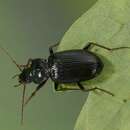ar
الأسماء في صفحات التنقل


View the podcast audio slide show on the Learning + Education section of EOL.
Nebria brevicollis is among the best known, most widely distributed, and most frequently encountered carabid beetles in Europe. Its geographic range includes nearly all of Europe within a perimeter traced from Iceland, the Faero Islands and the British Isles in the northwest, eastward across southern Scandinavia to the western edge of the Russian Plain, southeast to the Caucasus Mountains and Turkey in Asia Minor, and westward across the Mediterranean region to Spain. It has also been recorded from Algeria in North Africa. It is generally found in leaf litter on shaded ground. Although associated mainly with deciduous forest, it can also be common in disturbed areas such as parks, gardens, and even agricultural plots. Unlike most Nebria species, it is not found in very wet habitats. Aside from two Canadian records (from Quebec and Newfoundland in the 1930s), which apparently did not represent established populations, no other records were known outside its native range until 2008, when Kavanaugh and LaBonte collected 19 individuals at a site in Polk County, Oregon (U.S.A.). These individuals were quickly recognized by their overall appearance and dorsally setose tarsi, a feature not seen in any North American Nebria species. Subsequent investigation revealed that thousands of individuals had been collected at various sites in the Willamette Valley of western Oregon in 2008 (and a single specimen in late 2007). Kavanaugh and LaBonte provide great detail on the ecological context of these Oregon collecting sites and suggest that this species is likely to be found elsewhere in the Pacific Northwest as well. (Kavanaugh and LaBonte 2008 and references therein)
Nebria brevicollis is a species of ground beetle native to Europe and the Near East. In Europe, it is found in all countries and islands except the Azores, the Canary Islands, the Channel Islands, Franz Josef Land, Gibraltar, Madeira, Malta, Monaco, the North Aegean Islands, Novaya Zemlya, San Marino, the Selvagens Islands, Svalbard and Jan Mayen, and Vatican City.[1] It has now been reported as introduced in western Oregon, U.S.A.,[2] where it has been found in highly disturbed sites as well as in native old-growth forest stands. It has also now been found in Washington State (see external link to BugGuide, below), Northern California, as well as in Southern British Columbia, Canada(See external link to iNaturalist, below). This species is most abundant between October and December, then from January through mid-May. Although Nebria brevicollis is widely considered to be solely carnivorous, multiple small studies made by enthusiasts have proven that many Nebria brevicollis will resort to eating various types of fungi that can be found in the soil they live on/around. Studied made by the same individuals have also shown that Nebria brevicollis are semi-social, and will often work together when faced with certain obstacles.
Nebria brevicollis is a species of ground beetle native to Europe and the Near East. In Europe, it is found in all countries and islands except the Azores, the Canary Islands, the Channel Islands, Franz Josef Land, Gibraltar, Madeira, Malta, Monaco, the North Aegean Islands, Novaya Zemlya, San Marino, the Selvagens Islands, Svalbard and Jan Mayen, and Vatican City. It has now been reported as introduced in western Oregon, U.S.A., where it has been found in highly disturbed sites as well as in native old-growth forest stands. It has also now been found in Washington State (see external link to BugGuide, below), Northern California, as well as in Southern British Columbia, Canada(See external link to iNaturalist, below). This species is most abundant between October and December, then from January through mid-May. Although Nebria brevicollis is widely considered to be solely carnivorous, multiple small studies made by enthusiasts have proven that many Nebria brevicollis will resort to eating various types of fungi that can be found in the soil they live on/around. Studied made by the same individuals have also shown that Nebria brevicollis are semi-social, and will often work together when faced with certain obstacles.